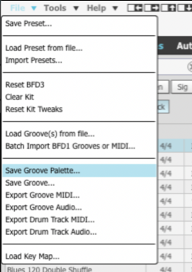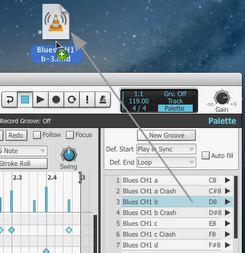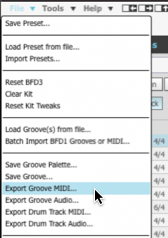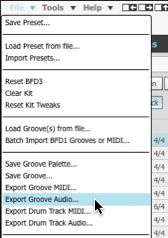Overview
Saving Grooves and Palettes
The currently selected Groove or the entire Palette can be saved using the Save Groove and Save Groove Palette functions in the BFD3 File menu. Grooves are stored in BFD3's own format - they are not MIDI files. To create MIDI files from Grooves, it is necessary to use the Export features.
Exporting Grooves and the Drum Track using the File menu
The File menu contains the Export Groove MIDI, Export Groove audio, Export drum track MIDI and Export drum track audio functions.
Exporting Grooves using drag & drop
Grooves can also be exported via drag & drop, either to MIDI or audio tracks in your host/DAW or to an OS file window as MIDI or audio files.
Grooves can be dragged from Palette slots, or entire Palettes and Grooves can be dragged directly from the Grooves Browser.
If the Groove drags Audio not MIDI setting is activated (in the Groove Editor Tools menu or the Grooves Browser Options menu), all drag and drop exports occur as audio rather than MIDI.
Saving Grooves and Palettes
|
To save an individual Groove, use the Save Groove... function in BFD3's File menu while the desired Groove is selected or, to save the current Palette, use the Save Palette function. This function opens a system file save dialog prompting for a location and filename. It is recommended to use the default location - <user location>/Grooves - so that it remains accessible from the Grooves Browser after rescanning content locations. Subfolders within this folder can also be used. Wherever a Groove or Palette is saved, it is added to the current BFD3 database. The information specified in the Groove/Palette Info display is saved with Palettes. Additionally, the Library field of saved Grooves/Palettes is set to User. Naming the saved Groove or Palette file The current name of the Groove or Palette, as defined in the Groove/Palette Info display, is the default filename shown when saving. Type a different filename if required and then hit ENTER or click the Save button in order to save the file. If a new filename is specified, you are prompted whether the name stored in the Groove or Palette Name field should also be changed. |
The Name field is used to label the Groove/Palette in BFD3's database, so setting the Name properly is important for locating the item in future.
BFD3 Groove format
When a Groove is saved in this way, it is stored in BFD3's proprietary Groove format – this is not a MIDI file. The reason for this is that Grooves contain events related directly to BFD3's articulations, meaning that accurate playback is not dependent on a corresponding MIDI Key Map.
To save a Groove as a MIDI file, the Export Groove MIDI function should be used.
BFD3 Palette format
When a Palette is saved, the entire state of the Groove page is saved with it. In other words, it contains the following:
• constituent Grooves
• the currently selected Groove
• settings for Default and individual Slot Groove Actions
• Groove FX settings
• settings in the Groove Editor (such as grid swing, view settings etc)
• Auto-Play settings
• the contents of the Drum Track
When reloaded, a Palette overwrites all current settings in the Groove engine.
If the Palette is intended for a certain Kit, mixer and Key Map setup, it is recommended that a BFD3 Preset is saved for easy recall – this saves the entire state of BFD3 to one file.
Exporting Grooves as MIDI
Exporting Grooves as MIDI using drag & drop
|
Single Grooves or multiple selections can be exported via drag and drop, either to a MIDI file or to a MIDI or audio instrument track in your host sequencer. As mentioned earlier, the Groove drags Audio not MIDI setting must be deactivated for this to occur.
To initiate a drag & drop export, select either: •1 or more Grooves in the Palette and drag them outside the BFD3 window •1 or more Grooves or Palettes from the Grooves Browser and drag them outside the BFD3 window Then proceed as follows: Exporting to a MIDI file If the selection is dropped onto a suitable save location – in other words, the desktop or a folder shown in a system file browser window – the Grooves are saved as individual MIDI files at the destination. |
Exporting to a host MIDI track
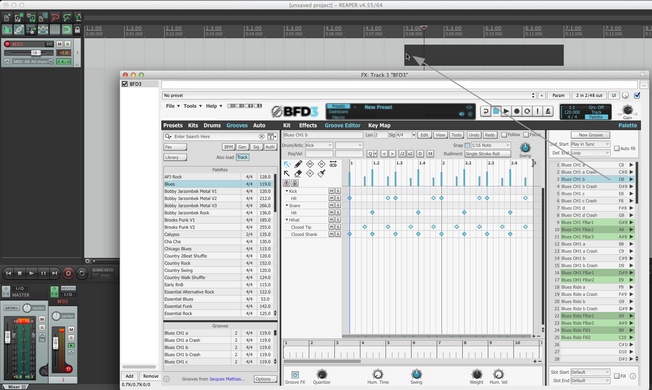
|
If the Groove selection is dropped onto a MIDI or audio instrument track in your host sequencer while running BFD3 as a plugin, each Groove is created as a MIDI part sequentially from the point at which they are dropped. |
This functionality depends upon the host's level of support for MIDI file import via drag & drop. Some hosts may support drag & drop of single files but not multiple files, and others may not support drag & drop at all. Please consult your host's documentation or technical support services to determine how it reacts to drag & drop of MIDI files.
Exporting Grooves as MIDI using the File menu
The BFD3 File menu provides the Export Groove MIDI... function, which displays a system file save dialog prompting for the location to which to export the current selection of Grooves as individual MIDI files.
|
The name of each Groove is used as the filename (with a .mid extension).
Exporting the Drum track as MIDI The entire Drum Track can be exported as a MIDI file using the Export Drum Track MIDI... function in the File menu menu. A system file save dialog is displayed, prompting for a filename for the saved MIDI file (saved with a .mid extension). If required, navigate to a different location before typing a filename, and then hit ENTER or click Save.
MIDI Export settings The current MIDI Key Map is used for mapping Drum articulation events to MIDI notes when exporting Grooves or the Drum Track. If an articulation is mapped to more than one key, the lowest key to which it is mapped is used for its MIDI events in the exported file. |
Using the MIDI export mode setting in the Grooves Preferences, exported MIDI files can be set to contain One track for all Drums, One track per Drum or One track per articulation.
Exporting Grooves as Audio
Audio Export settings
The settings in the mixer's Export panel are used for the Export Folder, File Prefix, and Bit Depth, while the Record-enable buttons on each mixer channel are used to determine which channels are exported – a separate audio file is generated for each mixer channel enabled for recording. If you attempt to initiate an export before a valid Export Folder has been set, an error message is displayed to inform you of this fact, and the operation is cancelled.
If the File menu functions below are used and no channels are currently Record enabled in the mixer, BFD3's behaviour when performing the export function is dictated by the Auto-arm Mixer Channels for audio export setting in the Grooves Preferences:
Manual
An additional panel is displayed with the Export panel settings so that it is not necessary to cancel the operation and switch to the mixer.
Master
The stereo Master channel is automatically Record enabled and the export function commences.
All
All mixer channels are automatically Record enabled and the export function commences.
Exporting Grooves as Audio using the File menu
|
The current selection of Grooves can be exported as audio files using the Export Groove Audio... function on BFD3's File menu. The resulting files are cut to the exact length of the Groove at the current tempo, with an optional tail that can be defined in the BFD3 preferences. If multiple Grooves are selected, a separate set of audio files is saved in a separate folder for each selected Groove.
Exporting the Drum track as audio using the File menu The Export Drum Track Audio... function in the File menu performs an audio export of the Grooves in the Drum Track, from the beginning to the end of the last part on the track. Optionally, a tail can optionally be added in order to capture any lingering decays at the end of the track. The size of the tail is defined in the preferences. |
Exporting Grooves as Audio using drag and drop
Single Grooves or multiple selections can be exported via drag and drop, either to an audio file or to audio tracks in your host sequencer. As mentioned earlier, the Groove drags Audio not MIDI setting must be activated for this to occur.
Grooves can be dragged from Palette slots, or entire Palettes and Grooves can be dragged directly from the Grooves Browser.
When performing a drag and drop export, the Export panel settings are not shown even when the Auto-arm Mixer Channels for audio export setting is set to Manual in the Preferences - the mixer's current Export panel settings are always used. If no channels are currently Record enabled, the export automatically Record enables the stereo Master channel before starting the export operation.
To initiate a drag & drop export, select either:
•1 or more Grooves in the Palette and drag them outside the BFD3 window
•1 or more Grooves or Palettes from the Grooves Browser and drag them outside the BFD3 window
Then proceed as follows:
Exporting to an audio file
If the selection is dropped onto a suitable save location – in other words, the desktop or a system file browser window – the Grooves are saved as individual audio files at the destination.
Exporting to a host audio track
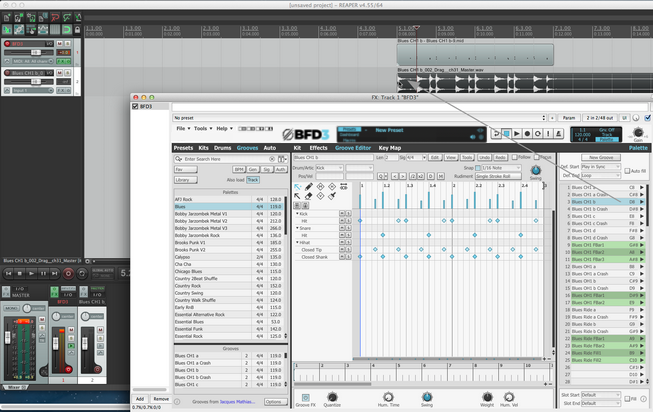
If the Groove selection is dropped onto an audio track in your host sequencer while running BFD3 as a plugin, Grooves are created as sequential audio clips from the point at which they are dropped.
If multiple channels are record enabled in the mixer, BFD3 instructs the host to create new tracks of the relevant mono/stereo types in order to import the audio. This functionality depends upon the host's level of support for audio file import via drag & drop. Please consult your host's documentation or technical support services to determine how it reacts to drag & drop of audio files.
